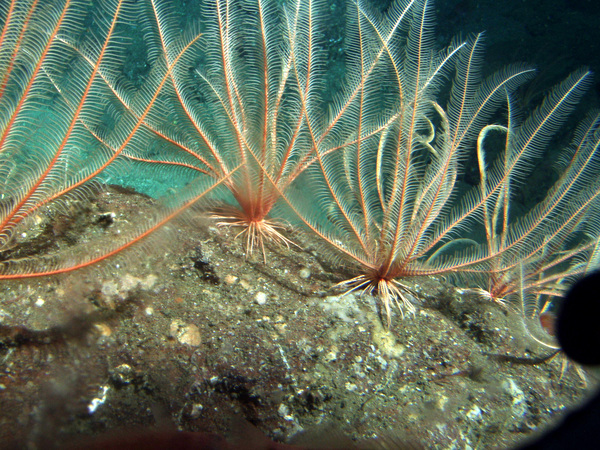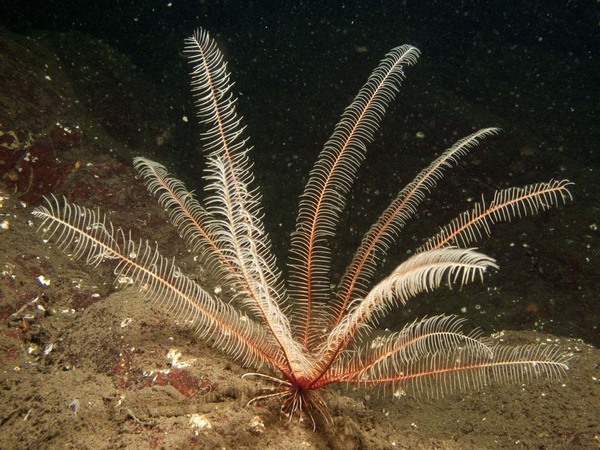Florometra serratissima is a captivating species of feather star known for its intricate structure and ecological significance. Found in tropical and subtropical waters, this species plays a crucial role in marine ecosystems. This article delves deep into its characteristics, habitat, life cycle, and interactions with other species, shedding light on its importance and the need for conservation.
Radial Symmetry
Long, Flexible Arms
Calcareous Ossicles
Suction Disk
Coloration and Camouflage
Distribution and Habitat of Florometra serratissima – Environmental Considerations
Habitat Analysis
How to Protect Florometra serratissima’s Habitat
The Food Chain of Florometra serratissima – Major Threats and Ecological Role
Major Predators
The Major Threats to Florometra serratissima
Asexual and Sexual Reproduction
Lifecycle Stages
Key Indicators of Health
The Ecological Role of Florometra serratissima and Its Relationships with Other Marine Species
Coral
Fish and Crustaceans
Marine Exploration
Aquarium Trade
Water Quality
Feeding
Tank Environment
10. Lifespan of Florometra serratissima
11. Conclusion: The Beauty and Vulnerability of Florometra serratissima
Florometra serratissima is a fascinating echinoderm species, and its distinctive features make it easily recognizable among other sea creatures. Here are the five key characteristics that define this feather star:
Radial Symmetry: As a typical feather star, Florometra serratissima exhibits radial symmetry, where its body is organized around a central axis. This allows the organism to expand its arms in all directions, enhancing its ability to feed and interact with its environment.
Long, Flexible Arms: The arms of Florometra serratissima are long and highly flexible, covered in small, branching structures called pinnules. These arms help the star to capture food particles from the water.
Calcareous Ossicles: The internal skeleton of Florometra serratissima consists of calcareous plates, which give it structural support and protection. These ossicles are what make it resilient against predators.
Suction Disk: Unlike many other sea stars, Florometra serratissima uses its small, disc-like body to attach to surfaces. This disc helps it anchor itself to coral or rock formations in the ocean.
Coloration and Camouflage: The color of Florometra serratissima ranges from light shades of yellow, orange, or brown to darker hues depending on its environment. This coloration helps it blend in with the surrounding coral reefs.
These features make Florometra serratissima both a fascinating subject of study and an important species in marine ecosystems.

Florometra serratissima is primarily found in tropical and subtropical regions, specifically in the Indo-Pacific Ocean. Its distribution extends from the coastlines of the Philippines to the Great Barrier Reef and various other tropical reef systems.
Coral Reefs: Florometra serratissima predominantly inhabits coral reefs, where it thrives in the rich biodiversity of these ecosystems. It attaches itself to coral or rocks using its basal disk and feeds on plankton and small organisms carried by water currents.
Depth Range: This feather star is usually found in shallow waters, ranging from depths of 10 meters to about 40 meters. However, some populations can extend deeper into the benthic zones where light penetration is limited.
Temperature: Florometra serratissima prefers warm waters, typically between 25°C to 28°C, which are ideal for its survival.
Protecting the habitat of Florometra serratissima is vital for maintaining its population. The major threats to its habitat include climate change, ocean acidification, coral bleaching, and destructive fishing practices. Conservation efforts should focus on:
Establishing Marine Protected Areas (MPAs): MPAs can provide refuge from overfishing, pollution, and habitat destruction. These areas help preserve coral reefs, the primary habitat of Florometra serratissima.
Reducing Pollution: Minimizing pollution, particularly plastic waste and toxic runoff from land, is critical in preserving the health of coral reefs and the species that rely on them.
Florometra serratissima plays an important role in marine food chains. It is a filter feeder, capturing plankton and small organic matter from the water column using its feathered arms. However, it is also part of the food web as prey to several marine predators.
Fish: Some species of fish, such as wrasses and triggerfish, may feed on feather stars.
Crustaceans: Certain crustaceans, including larger crabs and shrimp, may also feed on the arms or body of Florometra serratissima.
Habitat Degradation: The primary threat to Florometra serratissima is the degradation of coral reef ecosystems due to pollution, climate change, and unsustainable fishing practices.
Overfishing: Overfishing depletes fish populations that are crucial for maintaining the balance of the ecosystem, which indirectly affects the food sources for Florometra serratissima.
The reproductive strategy of Florometra serratissima is crucial to its survival and the health of its population.
Asexual Reproduction: Some species of feather stars, including Florometra serratissima, can reproduce asexually by regenerating lost arms, which may lead to the formation of new individuals.
Sexual Reproduction: Florometra serratissima also reproduces sexually, with separate male and female individuals. The fertilized eggs hatch into larvae, which eventually settle on the ocean floor and undergo metamorphosis into juvenile feather stars.

Larval Stage: After fertilization, Florometra serratissima undergoes a planktonic larval stage, where it drifts in the ocean currents.
Juvenile Stage: Once the larvae settle on a hard surface, they begin to transform into juvenile feather stars, developing the signature arms and filtering structures.
Adult Stage: The adult Florometra serratissima is fully capable of feeding, reproducing, and engaging in its ecological role within the reef.
To determine the health of Florometra serratissima, marine biologists often observe its physical condition, feeding behavior, and the clarity of its environment.
Arm Regeneration: Healthy individuals can regenerate lost arms over time. A Florometra serratissima with damaged or missing arms that cannot regenerate may be stressed.
Feeding Behavior: An active and healthy Florometra serratissima will display consistent feeding behavior. If it appears to be sluggish or not feeding, this could be a sign of illness or environmental stress.
Color and Appearance: Bright and vibrant coloration is often associated with health, while pale or discolored individuals may be suffering from environmental changes.
Florometra serratissima is an important member of the marine ecosystem, particularly in coral reef habitats. It interacts with various organisms, including:
Coral: It often lives in close association with coral, using the reef as a substrate for attachment and as a food source.
Fish and Crustaceans: As both predator and prey, Florometra serratissima contributes to the cycling of nutrients and the balance of the food web.
Ongoing scientific research has provided valuable insights into the biology, ecology, and conservation of Florometra serratissima. Recent studies have focused on its genetic diversity, reproductive behavior, and ecological interactions within coral reef ecosystems.
Humans interact with Florometra serratissima in various ways, primarily through marine exploration and aquarium trade.
Marine Exploration: Researchers study Florometra serratissima for its unique characteristics and role in coral reef ecosystems.
Aquarium Trade: Feather stars, including Florometra serratissima, are often sold in the aquarium trade. However, they require specific conditions to thrive in captivity.
If you're considering keeping Florometra serratissima in a marine aquarium, it’s important to replicate its natural environment as closely as possible.
Water Quality: Ensure that the water temperature, salinity, and pH are appropriate for the species.
Feeding: Provide regular access to plankton and other small food sources. Supplement with nutrient-rich foods to support its filter-feeding lifestyle.
Tank Environment: Create a stable environment with plenty of live rock or coral for attachment and protection.
The lifespan of Florometra serratissima can vary depending on environmental conditions, but under optimal circumstances, it can live for several years. Typically, in the wild, this species may live anywhere from 5 to 10 years, though some individuals have been known to survive longer in protected marine environments or aquariums with well-maintained conditions.
The lifespan of Florometra serratissima is influenced by several factors, including:
Water Quality: Clear, clean water free from pollutants is crucial for the survival and health of this species.
Predator Pressure: While Florometra serratissima has some natural predators, the presence of large predators can shorten its life expectancy, especially if it cannot hide effectively.
Reproductive Success: The ability of Florometra serratissima to reproduce successfully impacts its population and longevity, as individuals that reproduce and regenerate limbs can extend their overall lifespan.
Florometra serratissima is a remarkable marine organism that plays a crucial role in the health of coral reef ecosystems. Its distinct characteristics, such as its long, flexible arms, radial symmetry, and filtration feeding system, make it an extraordinary species within the echinoderm family.
However, despite its ability to regenerate and its adaptability in various habitats, Florometra serratissima is not immune to environmental threats. The degradation of coral reefs, pollution, and the effects of climate change pose significant risks to its survival. Protecting this species requires concerted efforts in marine conservation, including the creation of marine protected areas, pollution control, and education on the ecological importance of such creatures.
For aquarists, caring for Florometra serratissima in a reef tank can be rewarding, but it demands a commitment to maintaining optimal water conditions, a proper diet, and a stable environment. By understanding its biology, reproduction, and ecological role, we can better appreciate the fragility and beauty of Florometra serratissima and contribute to its preservation.
The lifespan of Florometra serratissima is a reminder of the need for sustainable practices in both the wild and in captivity, ensuring that this magnificent feather star continues to thrive for generations to come.
animal tags: florometra-serratissima
We created this article in conjunction with AI technology, then made sure it was fact-checked and edited by a Animals Top editor.